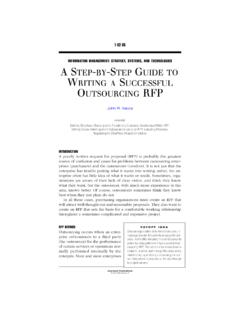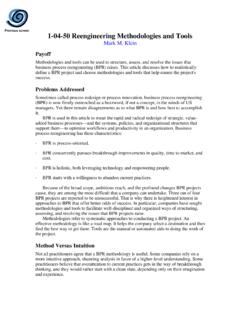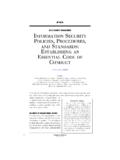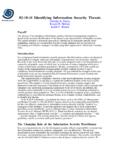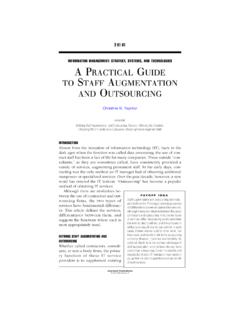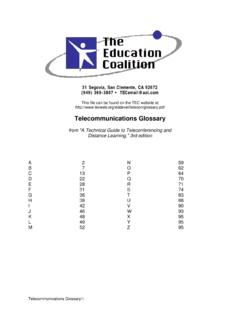Transcription of Implementing an Application Change Control System
1 82-02-50 Implementing an Application Change Previous screen Control System H. Van Tran Cynthia D. Heagy Payoff Traditionally, firms have adopted stringent systems development controls to ensure that new Application systems are efficient and reliable in meeting an organization's and the users' needs. Application Change controls have been neglected, however, despite the fact that large firms generally spend between 60% and 80% of their Application software dollars on maintenance activities. A new breed of Application Change Control System is emerging that ensures that all changes made to Application systems are properly authorized, tested, and approved for implementation. This article examines the design and implementation of these Control systems.
2 Introduction New Application systems are typically developed by in-house programmers in a development environment and then transferred into a production environment to be used to support daily business operations. After being placed in production, however, Application systems frequently must be changed to improve the efficiency of the applications , adjust the applications to changing business conditions, or correct defects in the applications . Application changes affect computer programs, screen and file definitions, and Job Control Language instructions, with the bulk of the changes being made to computer programs. In-house applications systems development and maintenance have different Control objectives. Systems development controls provide assurance that Application systems are efficient and reliable and meet the organization's and the users'needs.
3 Application Change controls ensure that all changes to Application components are properly authorized, tested, and approved for implementation. If Application Change controls are adequate, business users can be confident that the Application System being used is the one that was initially developed but with known and approved changes. In general, large firms spend 60% to 80% of their Application software dollars on maintenance activities and the remainder on systems development activities. Each new large systems development project generally is expensive and highly visible; in contrast, each Application System Change usually is small and low-key. The high visibility and costliness of large systems development projects have compelled firms to adopt stringent systems development controls; however, they have neglected Application Change controls.
4 Large systems development controls are grounded in a defined systems development life cycle methodology. The development project is subdivided into phases with tightly controlled milestones, deadlines, coding and testing schedules, and budgets. Moreover, the roles and responsibilities of both programmers and System owners are clearly defined. (A. System owner is an individual in a user department who is a liaison between the business users and the programmers and who has stewardship over a particular Application System .). However, substantial systems development controls would yield little value if subsequent modifications to Application systems were to undermine these expensive systems development controls. Thus, the integrity of an Application System could be in jeopardy without adequate Control over Application changes.
5 This article describes an emerging new breed of Application Control systems. Specifically, the article discusses: Traditional approaches to Application changes. Risks associated with these traditional approaches. Previous screen Design and implementation of an Application Change Control System . Traditional Approaches to Application Changes In the authors' experience as consultants, traditional approaches to Application changes are used by many large mainframe computer centers. Firms that do not use contemporary Application Control procedures store computer programs in common libraries on secondary storage devices. For example, all Common Business Oriented Language source program (which contain English-like instructions) are stored in a common production source programs library.
6 All COBOL load or machine-executable programs (which contain binary or machine-readable instructions) are stored in a common production load program library. When creating a new program, the programmer initially codes a source programs and then uses a compiler to generate its load program equivalent. Both programs, after being fully tested, are moved into the common production source and load program libraries, where the load program is executed by the computer to support the organization's daily business operations. The program Change process consists of a series of tasks. When a program Change is requested and authorized by the System owner, a programmer copies the source programs from the common production source programs library into the programmer's development source programs library.
7 Development libraries are private libraries that can be created, deleted, read, or written to by a particular programmer and no one else. After the source programs is in the private development source programs library, the programmer modifies the program, compiles the program to produce a load program, links the program with all essential compiled subroutine, tests the program by executing the load program using test data, and informs the System owner of the successful Change . Typically, the System owner approves the Change without any additional testing and authorizes the copying of both source and load programs to the common production source and load libraries. The newly generated load program is now used for daily business operations.
8 Traditionally, organizations have taken two approaches to Application changes. One approach provides hundreds of maintenance programmer with update access to the two common production libraries ( , source and load ) so they can copy programs directly from production to development and back to production at any time. After being given update access, a programmer can read, modify, and delete any program stored in common production libraries. The main advantage of this approach is efficiency, because programmers can move changed programs to production libraries in a timely fashion without any red tape, burdensome paperwork, or time-consuming bureaucracy. However, this is a dangerous approach to Application changes. Because hundreds of maintenance programmers have update access to common production libraries, intentional errors and fatal attacks by disgruntled programmers are difficult to prevent.
9 The other traditional approach to Application changes uses a librarian to perform the task of copying programs from development libraries to production libraries. In this approach, only the librarian has update access to common production libraries. As a result, the risk of attacks is greatly reduced. After a program has been modified successfully and tested by a programmer, forms must be completed authorizing the librarian to move both the source and the load programs from the development libraries to the production libraries. One disadvantage of this second approach is that moving the changed programs into the production libraries can take several days under this procedure. For emergency changes, the use of a librarian hinders the timely update of production libraries.
10 Therefore, daily business operations that depend on the successful outcome of these changes may be Previous screen disrupted. Risks Associated with the Traditional Approaches In addition to the unique inherent risks in each of the two traditional approaches to Application changes, they share several other risks. For example, use of common production libraries causes information privacy problems, because a programmer who has read access to the production source library can read and copy any program in this library. Disgruntled or dishonest programmers can engage in industrial espionage by copying proprietary programs for sale to the competition. In addition, if only the programmer tests changes, erroneous program instructions can slip into production and the System may fail to meet the needs of the organization and the users.

